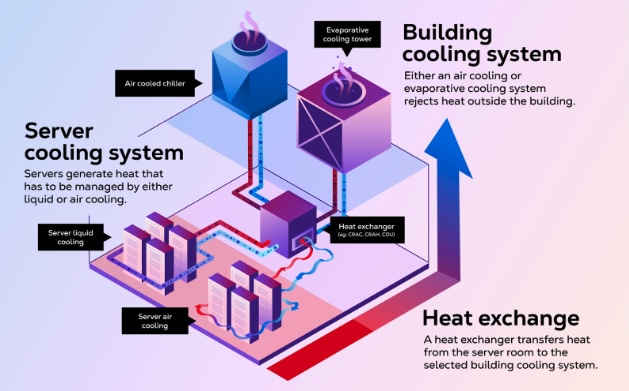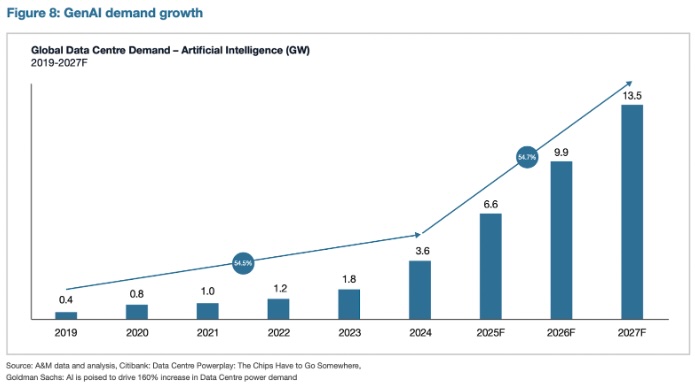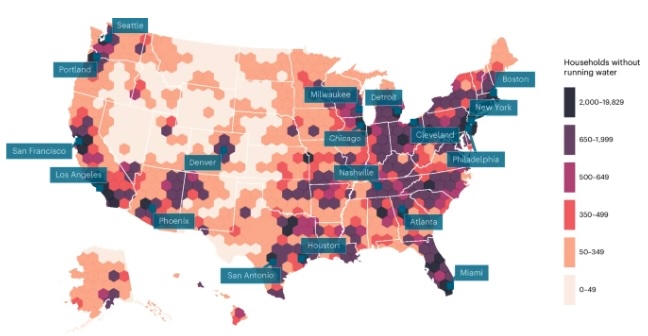Loading...
Home > Newsletters > Sept. 2, 2025 > AI, Data Centers, and Potable Water
Sept. 2, 2025
AI, Data Centers, and Potable Water
By Abby Lopez

IFI investments in AI data centers are booming, but their heavy reliance on potable water for cooling is straining communities and the environment. Exploring the balance between technological growth and responsible resource use is more urgent than ever.
Why AI Needs Data Centers
Data centers are essential to having modern technology work efficiently and consistently. Recently, there has been an unprecedented increase in investments for building data centers to help advance artificial intelligence’s capabilities, over $364 billion this past year from American companies (Litchtenberg 2025). With a high demand, AI needs data centers to meet these growing needs.

Data centers hold large amounts of data through hardware and software that is essential to companies’ everyday operations, networks, security, and more. To become more efficient and accurate, AI models need to be trained with more data and require a drastic increase in parallel processing when solving complex processing problems, through breaking this down into smaller ones by simultaneously using smaller processors (Flinders & Smalley 2024). In other words, it is like a team breaking down a major challenge by everyone having their assigned task that will contribute to the final solution. This can help us drastically reduce the amount of time and resources needed to address some of the major problems we face today by enabling more accurate health diagnoses and mitigating global warming. However, in that process, water consumption from these centers’ cooling systems is a concerning issue.
Cooling Systems and Water Consumption
One of the most crucial aspects to operating data centers is being able to cool down the servers, routers, storage systems, and other hardware that run consistently. There are various cooling systems, some of which include air, liquid, immersion, evaporative, and free cooling (Chien 2025). The most common forms are air cooling and evaporative cooling, which involve using municipal drinking water. For air cooling systems, more energy is used, but less water is consumed, and vice versa for evaporative cooling systems. Regardless, water efficiently absorbs and redistributes heat, making it an ideal medium for cooling systems. Here is a visualization of how water is used in cooling systems (Chien 2025):

Additionally, potable water is used for cooling systems because other water sources cause microbial build-up through exposure to nutrients, sunlight, or air (Veolia 2024). Microbial build-up or materials eroding can cause disruptions to cooling systems and disrupt data centers’ ability to operate. Municipal drinking water, or potable water, is accessible and reliable through the systems they were built in, making them optimal for large-scale cooling systems.
Although water is great for cooling down these centers, there are societal and environmental impacts. To view the impact of data centers holistically, we need to consider everyone involved in this, including those affected by these infrastructures: communities.
Community Impact
For companies, now is an optimal time to develop more data centers to meet the increasing demand in computational power in order to improve cloud infrastructures, and use new power and cooling systems to their advantage (Frank 2025). Yet, in that process, due to varying regulations on what information is needed to publish to the public, private companies do not explicitly state how much water they use on these data centers.
“In September, Mike Rogoway, a reporter for The Oregonian, asked officials in The Dalles to disclose how much water Google used in 2020 and the city's total industry water usage over the past five years.
The City of The Dalles resisted, calling that information a trade secret that isn't subject to disclosure under state public records law. According to The Oregonian, Google has a non-disclosure agreement with the city,” – Thomas Claburn, 2021
Communities may not entirely know what they are signing up for, and if they do, it can be a skewed perception without comprehensive information on the environmental and societal impact of these companies. A large number of these data centers are being built in places where potable water is already scarce (Martins & Amorim 2025). For companies that do release some of their data on water consumption, “water stress” is how they label areas where potable water is scarce: in 2021, one in five data centers were built in places where “water stress” was moderate to high (Md Abu Bakar Siddik et al 2021). Therefore, building data centers where water is hard to get already can worsen the situation for communities living there.
Whenever new infrastructure is built in communities, utilities are repaid at a base rate cost. This means that the increase in electricity usage cost is spread evenly throughout the people who live in that area (Gutierrez, Woody, Smith 2025). Apart from the added costs, although there have been efforts to improve “plumbing poverty,” areas without accessible water, they have not been equitable to people of color since they were the ones who continued to be affected (Meehan, K., Jurjevich, J.R., Everitt, L. et al 2024). With increased cost to utilities and decreased accessibility to potable water, data centers can increase the disproportion among already affected areas, making this a heavier burden to the already-strained, low-income populations. Below is a map of areas where water was not accessible between 2017 to 2021, and these overlap with where data centers are being built in the US (Meehan, K., Jurjevich, J.R., Everitt, L. et al 2024):

Water disruption takes may forms: a limited window of time to use water, increased water container cost, and even an increase in health issues. Some of those health issues can be long-term, such as respiratory conditions, gastrointestinal illnesses, and cancer (Cushing, Dobbin, Jelks, Liu, Morello-Frosch 2023). Another consequence of building these data centers in vulnerable areas could lead to long-term health effects to the community, which shows how crucial it is to consider societal impacts when developing these projects.
Therefore, when narrowing down on data centers and their impact on potable water in the communities in which they operate, the data centers negatively affect the people, most of whom are not fully aware of these effects.
International Financial Institution Involvement
International financial institutions (IFIs) are heavily involved in financing data centers for the expansion of AI technology. The International Finance Corporation, “the largest global development institution focused on the private sector in emerging markets,” and 6 other IFIs invested over $900 million in data centers built in Malaysia (IFC 2024). This year Raxio signed for $100 million with the IFC to build a data center in Sub-Saharan Africa (Raxio 2025). In the United States, two weeks prior to releasing this newsletter, JP Morgan and Mitsubishi UFJ Financial Group were negotiating a $22 billion plan to develop a 1,200-acre data center in Texas (Gara & Platt 2025). IFIs are greatly involved in funding the development of data centers across the world. With great financial influence, it is important to hear from IFIs about their understanding of how these data centers will affect the communities in which they’re built.
BBVA. "R. Soler: “BBVA is the 4 Largest Bank Financing Data Centers in the US"." NEWS BBVA, 13 June 2025, www.bbva.com/en/sustainability/javier-rodriguez-soler-bbva-is-the-4th-largest-bank-financing-data-centers-in-the-us/
Claburn, Thomas. "Oregon City Fights to Keep Google's Water Use Secret." The Register: Enterprise Technology News and Analysis, 5 Nov. 2021, www.theregister.com/2021/11/05/oregon_google_water?utm_source=chatgpt.com
"Draining Cities Dry: the Giant Tech Companies Queueing Up to Build Datacentres in Drought-hit Latin America." The Guardian, 22 May 2025, www.theguardian.com/global-development/2025/may/22/datacentre-drought-chinese-social-media-supercomputers-brazil-latin-america
"Future of Data Center Cooling." Digital Realty | Data Center Services & Colocation, www.digitalrealty.com/resources/articles/future-of-data-center-cooling.
"Google Search." Nature, www.nature.com/articles/s44284-024-00180-z
Global Data Centre Insights 2024, www.alvarezandmarsal.com/sites/default/files/2024-11/Global%20Data%20Centre%20Insights%202024-final.pdf Accessed 27 Aug. 2025.
"IFC and Global Lenders Finance Yondr’s Data Center Project in Malaysia." IFC, www.ifc.org/en/pressroom/2024/ifc-and-global-lenders-finance-yondr-s-data-center-project-in-malaysia
"Introduction." Industrial Water & Process Treatment Technologies & Solutions | Veolia, www.watertechnologies.com/handbook/introduction
"JPMorgan and MUFG Near $22bn Data Centre Financing Deal in Texas." Financial Times, 20 Aug. 2025, www.ft.com/content/00261ab8-64d8-43a4-99d9-35a2017dbe2b
"Just a Moment..." Just a Moment.., www.healthaffairs.org/content/briefs/water-insecurity-and-population-health-implications-health-equity-and-policy
Lichtenberg, Nick. “Spending on AI Data Centers Is so Massive That It’s Taken a Bigger Chunk of GDP Growth than Shopping-and It Could Crash the American Economy.” Fortune, Fortune, 7 Aug. 2025, fortune.com/2025/08/06/data-center-artificial-intelligence-bubble-consumer-spending-economy/
Md Abu Bakar Siddik1, Arman Shehabi2 and Landon Marston1,∗, et al. "The environmental footprint of data centers in the United States." iopscience.iop.org, iopscience.iop.org/article/10.1088/1748-9326/abfba1/pdf
"Raxio Secures $100 Million from IFC to Develop Leading Sub-Saharan African Data Center Platform." Raxio Group, 16 May 2025, www.raxiogroup.com/raxio-secures-100-million-from-ifc-to-develop-leading-sub-saharan-african-data-center-platform/
Setmajer, Alex. "How Data Centers Use Water, and How We’re Working to Use Water Responsibly." blog.equinix.com, blog.equinix.com/blog/2024/09/19/how-data-centers-use-water-and-how-were-working-to-use-water-responsibly/
Stryker, Cole. "What Is Agentic AI?" IBM - United States, www.ibm.com/think/topics/agentic-ai.
"What is Parallel Computing?" IBM - United States, www.ibm.com/think/topics/parallel-computing